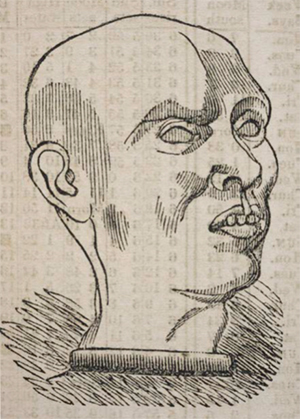
Excerpted from the text: “The above cut is a true representation of the head of Johnson, who murdered Murray in the city of New-York, about the year 1825. His bust denotes a temperament of the most unfavorable kind.... Add to this, very unfavorable phrenological developments, and we have the elements of Johnson’s character. His strongest organs were Acquisitiveness, Destructiveness, Secretiveness and Firmness, and these constituted the leading features in his character. They being perverted, rendered him extremely selfish, grovelling, cruel and hard hearted.”
The almanac is a genre of ephemeral—temporary or non-durable— publication that traces its history to the medieval period. These popular items originally consisted of calendars containing religious holidays, moon phases, and astronomical tables that provided an outlook on the upcoming year. Medical almanacs in particular were an important facet of pre-modern medicine as doctors took astrological information into consideration in the diagnosis and treatment of their patients.
By the eighteenth century, almanacs had become common household books that provided health and home tips along with calendrical features. They were also a popular medium for drug companies to advertise their wares, accompanied by horoscopes, songs, health advice, and other eye- catching features to attract buyers.
The Osler Library Almanac Collection consists of more than 500 medical almanacs from the nineteenth and twentieth centuries, most of which were printed by drug manufacturers. They are an important source of information about the lay medical culture of the period. The majority of almanacs in the collection were published in Canada, including Le livre de songes de Cléopâtre, published in French in Brockville, Ontario, and Morristown, New York, sometime between 1857 and 1881.This almanac provides readers with a guide to dream interpretation and advises them to purchase Dr. Morse’s Indian root pills.
The oldest almanacs in the collection are American, such as The Phrenological Almanac for 1841: Embellished with Fifty Engravings, Illustrative of the Science of Phrenology, which features essays on phrenology and phrenological diagrams in addition to calendars, including the typological drawing of “Johnson the Murderer” shown here, with an explanantory caption on Johnson’s character. The cheaper quality paper often used for these almanacs is noticable by the text bleeding through from the back of the page.
Examples of another popular form of inexpensive ephemeral publications are found in McGill’s chapbooks, many of which include similar “how-to” tips for the home. An equally interesting glimpse of popular household literature is offered by the Cookbook Collection, containing over seventeen hundred items dating from the eighteenth to the twentieth century.
